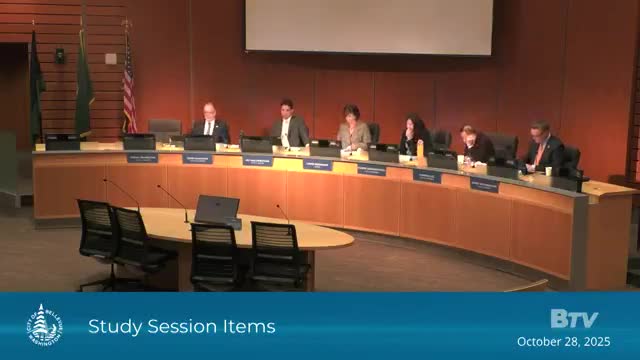Bellevue studies how residents see the city; outreach finds parks, safety and diversity top civic associations
October 29, 2025 | Bellevue, King County, Washington
This article was created by AI summarizing key points discussed. AI makes mistakes, so for full details and context, please refer to the video of the full meeting. Please report any errors so we can fix them. Report an error »

City staff and consultants briefed the Bellevue City Council on Oct. 28 on findings from a brand identity outreach effort aimed at shaping an updated city brand and community engagement strategy.
Michelle DeGrande, Bellevue’s chief communications officer, said the outreach used focus groups, a public survey and targeted outreach to community‑based organizations with the goal of making the city’s brand ‘‘resonate with our diverse communities and align with the city’s core values and vision.’’ She told the council, “This input will help us really begin developing the specific tactics that we will have in the work plan to begin making these brand enhancements as we go forward.”
The consultant team from DH Communications summarized the results: residents most often associated Bellevue with ‘‘beautiful parks and green spaces,’’ ‘‘safety and cleanliness,’’ business growth and the city’s affluence; focus‑group participants also highlighted diversity, culture and welcoming neighborhoods. The report noted a gap on some measures — for example, residents highly value ‘‘high‑quality services and a caring community’’ but did not always perceive the city government as representing those values as strongly.
Megan Hathaway, DH Communications’ research director, said the work produced six recommended focus areas: maximize high‑touch trusted communications; increase community voices in city materials; be proactive in communications; use visuals that reflect Bellevue’s beauty and diversity; expand language accessibility; and make transparency a priority. Ian Hansen, the consultants’ senior account executive, said the outreach also yielded practical channel preferences: the city website, email newsletters and the city’s “It’s Your City” newsletter were the sources residents most often cited for trusted information, with social media, community events and partners also important.
Councilmembers across the dais responded with questions about implementation and measurement. Councilmember Jared Neuenhaus said, “It’s not about what we say the brand is. It’s what the residents tell us the brand is,” urging staff to carry community insights into the final product. Several members emphasized co‑creation with community organizations and the need to meet residents where they are, not rely solely on people coming to City Hall.
City staff described next steps as (1) picking short‑term tactics that can be implemented within existing budgets, (2) building a work plan for larger items in 2026, and (3) establishing maintenance and cadence so the brand work is revisited as the city changes. DeGrande said some immediate actions are already under way, including a plain‑language framework and enhancements to translation and technology tools.
Councilmembers requested clearer metrics and suggested the city return with concrete tactics and costs. Staff said the outreach report will be used to develop a work plan and metrics that council can review as the project moves from assessment to implementation.
Michelle DeGrande, Bellevue’s chief communications officer, said the outreach used focus groups, a public survey and targeted outreach to community‑based organizations with the goal of making the city’s brand ‘‘resonate with our diverse communities and align with the city’s core values and vision.’’ She told the council, “This input will help us really begin developing the specific tactics that we will have in the work plan to begin making these brand enhancements as we go forward.”
The consultant team from DH Communications summarized the results: residents most often associated Bellevue with ‘‘beautiful parks and green spaces,’’ ‘‘safety and cleanliness,’’ business growth and the city’s affluence; focus‑group participants also highlighted diversity, culture and welcoming neighborhoods. The report noted a gap on some measures — for example, residents highly value ‘‘high‑quality services and a caring community’’ but did not always perceive the city government as representing those values as strongly.
Megan Hathaway, DH Communications’ research director, said the work produced six recommended focus areas: maximize high‑touch trusted communications; increase community voices in city materials; be proactive in communications; use visuals that reflect Bellevue’s beauty and diversity; expand language accessibility; and make transparency a priority. Ian Hansen, the consultants’ senior account executive, said the outreach also yielded practical channel preferences: the city website, email newsletters and the city’s “It’s Your City” newsletter were the sources residents most often cited for trusted information, with social media, community events and partners also important.
Councilmembers across the dais responded with questions about implementation and measurement. Councilmember Jared Neuenhaus said, “It’s not about what we say the brand is. It’s what the residents tell us the brand is,” urging staff to carry community insights into the final product. Several members emphasized co‑creation with community organizations and the need to meet residents where they are, not rely solely on people coming to City Hall.
City staff described next steps as (1) picking short‑term tactics that can be implemented within existing budgets, (2) building a work plan for larger items in 2026, and (3) establishing maintenance and cadence so the brand work is revisited as the city changes. DeGrande said some immediate actions are already under way, including a plain‑language framework and enhancements to translation and technology tools.
Councilmembers requested clearer metrics and suggested the city return with concrete tactics and costs. Staff said the outreach report will be used to develop a work plan and metrics that council can review as the project moves from assessment to implementation.
Don't Miss a Word: See the Full Meeting!
Go beyond summaries. Unlock every video, transcript, and key insight with a Founder Membership.
✓
Get instant access to full meeting videos
✓
Search and clip any phrase from complete transcripts
✓
Receive AI-powered summaries & custom alerts
✓
Enjoy lifetime, unrestricted access to government data
30-day money-back guarantee

